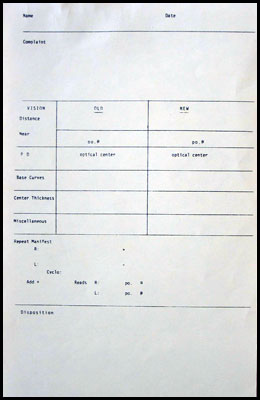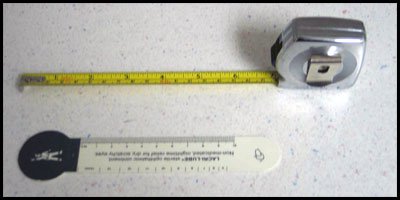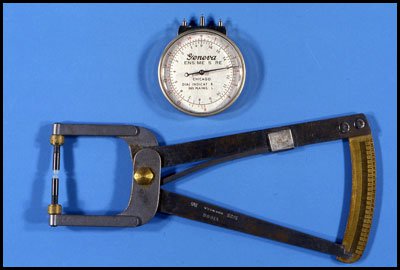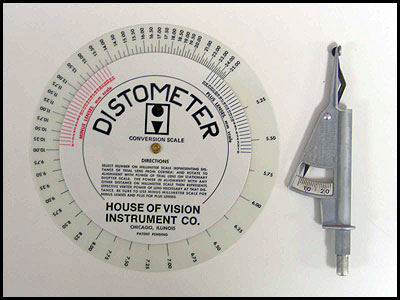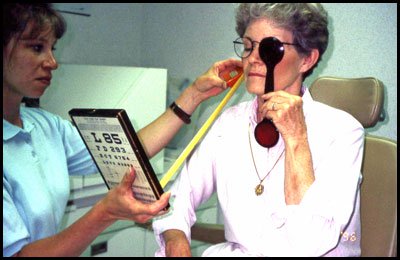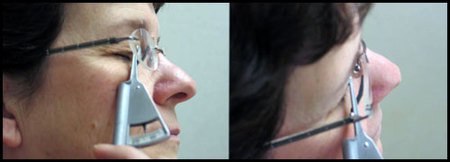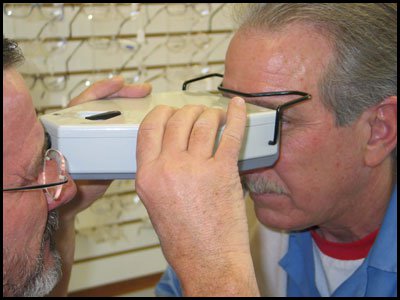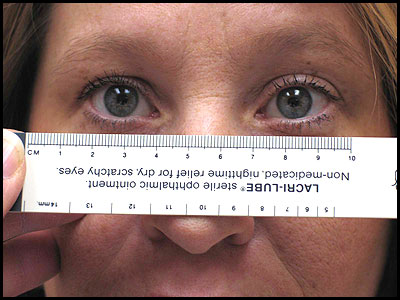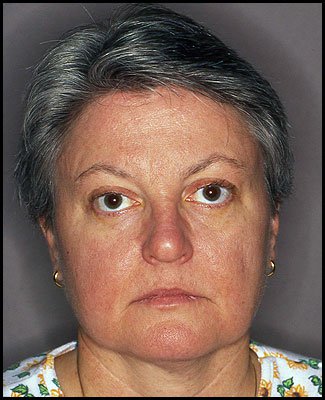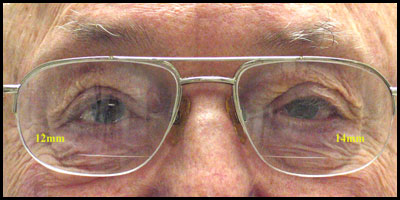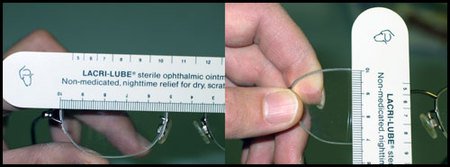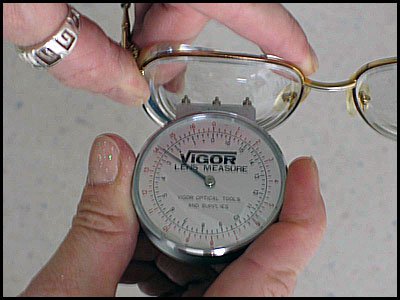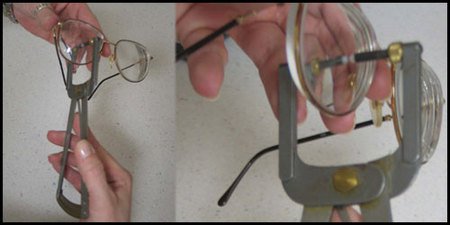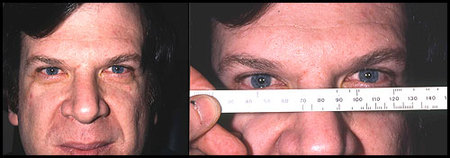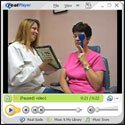The Care and Management of a Dissatisfied Refraction Patient
It is a truism that, “If you operate, you will have complications.” Wise surgeons plan ahead to avoid complications and to manage those that unavoidably occur. Also a truism – clinicians who prescribe glasses will have the occasional unhappy patient returning to the office. Planning for this event will both reduce its occurrence and ameliorate the “pain” of patient and refractionist alike.
One may ask, “Why bother? It is only a pair of glasses.” Some offices respond to patient complaints about spectacles with, “It takes time to get used to a new pair of glasses.” However, a patient who has paid $400 to $800 for glasses and experiences intolerable headaches or diplopia whenever he or she attempts to use them will not be a person who is likely to accept such platitudes.
Is this a significant problem? In the author’s practice, all spectacle prescriptions have a reminder at the bottom to “Please bring these glasses back to the office to have them checked for accuracy.” A majority of patients avail themselves of this service and, each year, approximately 5% of patients have some complaint about their new glasses. Similar rates of complaint have been documented in other offices. Although more than half of the complaints are minor and often are resolved with more time or minor frame adjustments, about 2% of prescriptions result in significant complaints. Each of these patients may require 20 to 30 minutes of office time for the clinician to determine the source of the problem, a charge for which these unhappy patients would consider inappropriate. After the clinician’s hourly rate is factored in, it is easy to see that unhappy refraction patients cost real money if they return, and loss of the patient if they do not.
These are truly unhappy patients, and some may be vehemently unhappy. They have struggled with unsatisfying glasses for weeks or months. They may have been put off by a receptionist for weeks before being allowed in the office door, and have probably been in the waiting room a while before the technician tried to evaluate the problem, and then have sat in the exam lane awaiting the clinician’s arrival. That patient may be worried that he or she made a mistake answering the refraction questions or that he or she may have a serious eye disorder causing the visual difficulties, or he or she is wondering who is going to pay for the remake of his spectacles. In this setting, the refractionist’s interaction with the patient may confirm the patient’s impression of the clinician as an excellent, caring physician or as an insensitive professional undeserving of his or her patronage.
Patient Complaints
Most of the complaints of patients with new spectacles fall into three categories – systemic, visual, and mechanical.
Systemic Complaints
Headache is perhaps the most frequent
complaint of unhappy refraction patients. The pain may vary from mild to severe
and may be perceived in the orbit, periorbital, or frontal regions, or temporal
or even occipital areas. Dizziness or a swimming sensation is a frequent
symptom with new glasses or new prescriptions and is sometimes associated with
nausea. Many patients will voice less-defined symptoms such as general fatigue
when using the glasses, “tired eyes,” a pulling sensation, burning,
or aching of the eyes. Some simply say, “I can’t use these glasses.
They make me sick.”
Visual Complaints
Blurred vision or just not seeing the way
the patient expected to see will bring patients back to your office. The
difficulty may be observed in the distance, when reading or performing other
near vision tasks, or when trying to see mid-range targets such as a computer
monitor or store shelves. The complaints may be more about distortion than
blur, although many patients will not differentiate between these two symptoms.
Your patient will not ignore diplopia that is created by a new spectacle
prescription. The list of symptoms also includes a sense of tilting of the
environment (floors, tables, walls), inappropriate image size or disparities in
the two eyes, distance judgment concerns, or inability to walk down stairs.
Frame or Mechanical Complaints
Patients often complain that
their frame fit is not satisfactory. It may feel too tight behind the ears or
on the nose. It may slide down the nose too readily. They may simply not like
the “look” of the frame. The bifocal may be too high, too low, too
small, or too large, or the bifocal line may be too prominent. The glasses may
fog over, or they may scratch too easily. Patients often wonder if the lens
edge is too thick and “shows too much.” Some patients are aware of a
rainbow effect at the periphery of their glasses.
Who Made the Mistake?
The source of the “error” in a patient’s glasses can be determined with an organized evaluation of the patient’s complaints. Almost all will fall into one of four categories: refractionist errors, optician errors, patient errors, and optical effects inherent in spectacle lenses.
Refractionist errors include incorrect reraction; incorrect prescription for the patient’s needs; incorrect transcription of the numbers from the record to the prescription; failure to identify and adjust the prescription for facial anomalies; asymmetric accommodative amplitude; anisometropic aniseikonia, or anisophoria; failure to include vertex distance on the prescription; or incorrect advice to the patient regarding choice of lenses.
Optician errors include incorrectly filling the prescription, wrong positioning of optical centers, wrong conversion of or neglecting to convert vertex distance of the prescription to that of the spectacles, errors in placement of bifocal, inappropriate changes of bifocal type, inappropriate changes in base curve or lens thickness, and failure to advise patients of the best frame for their specific facial and optical requirements.
Patient errors predominantly are caused by poor choice of the frame. Patient expectations may be inappropriate, resulting in complaints. Occasionally, a patient’s ability to tolerate perceptual changes is the cause of problems and, infrequently, a patient simply has decided not to buy the spectacles and is looking for a way to obtain a refund of the cost.
Optical effects of lenses are a frequent cause of problems, some of which are unavoidable. Changes in base curve or lens thickness may seem to be necessitated by changes in prescription power. Anisometropia may cause sensory or motility problems for even the most tolerant patient. Progressive addition lenses will always be associated with distortion of peripheral vision and a small reading area. However, many of these problems can be minimized with proper frame selection and adjustment of prescriptions.
Evaluation of the Dissatisfied Refraction Patient
Regardless of the problem’s origin, it is the refractionist’s responsibility to determine the source of the difficulty and attempt to satisfy the patient’s needs. An organized plan will expedite the evaluation and reduce the time required to identify the problem source. A preprinted form can be used to outline the information needed for technicians and physicians (Slide 1).
Each office should have the tools needed to carry out the planned evaluation. These include a lensometer, prism set or vertical and horizontal prism bars, a tape measure and a millimeter ruler (Slide 2), a lens clock and a lens calipers (Slide 3), and a distometer (Slide 4). An accommodative ruler (Slide 5) is useful, although the same determination of accommodative amplitude can be performed with a tape measure. A trial lens set and trial frame is the preferred refraction method for rechecking problem patients; however, a phoropter may be acceptable for a patient with a refractive error below 6 D. An autorefractor will not suffice as a means for re-evaluating the refraction of a patient with complaints.
|
|
|
|
|
As with all patient interactions, the workup of a dissatisfied refraction patient starts by taking a history. This should elicit as focused a description of the patient’s difficulties as possible and should include the following questions.
- Were the symptoms present immediately upon receiving the glasses?
- Does the problem occur every time they are worn, and as soon as they are put on or only after a period of wear? How long a period?
- Is the problem present with vision at all distances or only certain ones?
- Is the problem present only in certain positions of gaze or head positions or body positions?
Once the nature of the malady is known, the workup should proceed with the following steps:
- Measuring visual acuity of each eye at 6 m with old and new spectacles
- Determining the optimal reading position of each eye and the smallest type easily read at that distance, measured with the old and the new spectacles (Slide 6)
- Measuring the vertex distance of the old and new spectacles, if lens power is higher than 6 D (Slide 7)
- Measuring the interpupillary distance with pupillometer (Slide 8) or millimeter ruler (Slide 9) and comparing this distance to the distance between the optical centers of the old and new spectacles. Simultaneously, one should take note of any facial asymmetry (Slide 10)
- Measuring the seg (bifocal) height of the old and new spectacles. Also the seg position relative to each eye when the glasses are in their usual position on the patient’s face (Slide 11)
- Comparing lens size, vertical and horizontal dimensions, of the old and new spectacles (Slide 12)
- Comparing the base curve (front curve in the distance vision area) on each lens of the old and new spectacles (Slide 13)
- Comparing the center thickness of the old and new spectacles (Slide 14)
- Performing a repeat manifest refraction, by the best refractionist in the office. If there is any question of accuracy, a cycloplegic refraction should be performed, even in the early presbyope.
|
|
|
|
|
|
|
|
|
Potential Solutions
The most important step in satisfying an unhappy patient is obtaining the history. Listening carefully to a patient’s complaints provides the clinician with valuable information leading to the diagnosis of the problem source, but even more valuable may be the proof to the patient that his or her complaints have not broken the doctor-patient relationship and that the concerns will be resolved. The clinician’s obvious attention to the patient constitutes reassurance to the patient that his or her difficulties will be eliminated or reduced. Well over half the time, the history will allow a quick diagnosis, as the patient may disclose that he or she manually raises the frame to read or has double vision when reading or with distance vision, or the glasses hurt behind the ears, or another symptom that will define the origin of the problem.
Frame Problems
Problems from choice of frames: Frames that are too small may not permit adequate seg size to allow comfortable reading, especially with progressive addition lenses. Frames that are significantly larger than the previous pair will feel heavier and may produce an increased awareness of peripheral distortions when high index, “thin” lenses are used or when progressive addition lenses are present. A frame that is too loose, either because of imprecise match of bridge width to nasal width or from poorly adjusted temples, will slide down the nose and result in a bifocal position too low before the eyes, making them nonfunctional. The patient may explain the problem by complaining the glasses must be lifted to read better.
The choice of an unusually wide or oddly shaped frame may result in an unsightly, thick lens edge, usually at the temporal periphery in myopic spectacles. A rounder frame with optimal bevel placement on the lens edge will reduce this cosmetic defect as much as possible.
Problems from frame fitting: At times, the pantoscopic tilt may be a cause of cosmetic complaints or may result in reading problems in bifocal wearers. Frames may be too tight or too loose for the patient’s comfort. Often, simple adjustments of nose pads will eliminate many problems in spectacle positioning.
If the frame is the problem and the patient is in your office chair, you can be certain of the following: first, the optician will have to be the one to resolve the problem and, secondly, the patient has not yet been able to get the optician to resolve the problem. You will want to explain the cause to the patient, and if it can be rectified by adjustment of the current frame or if it will require changing to a different frame. Then as you send the patient back to the optician, it would be wise to make contact with the optician to be certain the modification is understood.
Prescription Problems
Some prescription problems are easy to diagnose. If the optician erred in filling the written prescription, the first moments of the office visit will be all that are needed.
If a refraction error or a mistake in transcription of the refraction to the prescription has been the cause of the problem, your repeat refraction should make this immediately apparent. Overminusing or underplusing may cause headache or asthenopia in a pre-presbyopic patient and blurred vision in presbyopes. An error in astigmatic axis and/or power may produce similar symptoms. An open acknowledgement of the source of the trouble, combined with assurance to the patient that he or she will not be charged to rectify it, will usually suffice to assuage both your sense of guilt and the patient’s animosity.
If the patient complains of blur and the glasses are over 6 D, the clinician should determine whether pulling them a few millimeters farther from the face or pushing them in as close as possible improves acuity. This may indicate a vertex distance problem. Every highly ametropic prescription should have vertex distance recorded, and it should be checked with the glasses when the patient returns with a vision disturbance. If the prescription had a vertex distance recorded and the optician did not convert the prescription for the actual spectacle vertex, another remake is in the future.
Problems in choice of bifocal are many and varied. One of the most common is making the bifocal too strong. Just because a patient says that a +2.25 D add makes print look sufficiently large and sharp in the office does not mean that it is the best choice. If the +2.25 D add results in an optimal reading distance of 13 inches in a 45-year-old patient but he or she actually wants to use the glasses for reading a newspaper set on a desk at 19 inches, then she will be back complaining within the week. The same +2.25 D add may be perfect for a 45-year-old tailor, although he or she may also want a +1.50 D add for reading at home. Each prescription must be “tailored” to each patient’s visual requirements.
Continuity is a comfort to most of us, and change forces adjustments upon us. When a patient chooses a new bifocal style (round to flat top, flat top to progressive, etc.), symptoms may occur. If the change is the only source of symptoms, it may be an instance when allowing additional time for adaptation will be successful. If not, a return to the previous bifocal type is necessary.
Loss of focal range with new glasses is a frequent cause of complaints in presbyopes.
If the distance prescription is changing more plus, the bifocal of the old glasses will be focusing farther out than when they were first prescribed, perhaps providing clear vision at such valuable positions as the store shelves, the computer monitor, or the dinner table. Suppose your patient was 48 when he received the last glasses, +0.50 OU with +1.75 add, providing reading at 17 inches. Now, 3 years later, the bifocal is focusing best at 22 inches and he is having problems reading, and the new refraction is found to be +1.00 OU and it takes a +2.00 add to read well at 17 inches. A new pair with stronger plus in the distance RX and in the bifocal may improve reading at the expense of loss of the mid-range, which he was seeing well through the old bifocal. It may be time to switch to trifocals!
If the distance prescription is shifting more minus, then the old glasses will be focusing closer through the bifocal than when first purchased. Let’s say your patient’s prescription at age 65 was -3.00 OU with a +2.25 add (power though bifocal = -0.75) which provided excellent reading at 16 inches. Now he has returned at age 69 and you find he is reading at 12 inches with the old glasses, though perhaps quite comfortable in doing so. His new refraction is found to be -4.25 D OU, which explains the shortened reading position, since his old glasses undercorrect his distance vision and leave him with 1.25 D of uncorrected myopia. The effect through the bifocal of his old glasses is the power through the bifocal (-0.75 D) plus the uncorrected myopia (a +1.25 D effect) resulting in a power of +0.50 D. When you prescribe a new pair with -4.25 D OU, which pushes the patient’s focus out to infinity, and a new add "appropriate" for age 69 (+2.50), the result is a loss of total plus effect at near (-4.25 + 2.50 = -1.75) and a focus through the bifocal which is farther out than the old lenses. The patient may complain of trouble reading from the loss of magnification. But if you increase the add power to keep the focus at 12 inches (+3.50), then the patient will have lost the mid-range focus which was present through the top of the underminused old glasses and will not be able to see in that range, through either the distance correction or the bifocal. Again, this is a time to consider trifocals.
Incorrectly matching the spectacles to a patient’s occupational or recreational needs generates many complaints. Computers and bifocals were not invented in the same century and the ergonomics of computer desks leaves much to be desired if you are a presbyope. Patients may need trifocals (with or without a large middle segment), a separate pair of glasses for desk work with bifocals set higher than usual, or a pair of bifocals in which the top has a prescription for the distance of the monitor and the bottom for the reading position. Many golfers cannot use bifocal or progressive lenses on the links, where they may have trouble focusing when “addressing the ball." They still need to be able to read the distance to the green or to keep score, so a very small bifocal set low in the frame may be ideal.
Lens Problems
When the prescription seems accurate but the patient has complaints, the source may be the lenses in the frame. If the optical centers were not positioned correctly before the line of sight, the patient may have diplopia or asthenopia from induced prism. Such misplacement may also cause reading problems if the eyes are too close to the edge of the bifocal when reading or outside the functional zone of progressive lenses. The author marks at the lensometer the spectacle optical centers and measures the interpupillary distance on all patients returning with complaints about their glasses.
Changing the base curve or center thickness of spectacles can produce asthenopia. One must maintain a high level of suspicion to avoid missing such cases. It should be standard practice to measure these parameters on the old and the new glasses.
With a change of astigmatic correction, especially a change of axis, some patients will experience a tilting of the environment upon first using the glasses. The greater the change from the old glasses to the new, the more likely a patient will be aware of this symptom. This seems to be the result of sensory adaptation to the retinal correspondence of the distortion in the old glasses, and a subsequent lack of adaptation to the retinal image of the new. In most instances, continued use of the new glasses results in satisfactory adaptation, and the world seems correctly proportioned. In fairly rare instances, it is necessary to prescribe less than accurate spectacles with the same astigmatic correction as the old glasses or a partial change toward the new refraction result. When doing so, it is wise to maintain the spherical equivalent found in the new refraction.
Many complaints are related to the bifocal in the glasses. The bifocal line may be too high, causing problems with distance vision or awareness of the blur from the bifocal when looking straight ahead. It may be too low, making it impossible to use the reading area effectively. This is a frequent problem with progressives, but may be present with any bifocal style. While the standard bifocal position is at the lower lid, the best bifocal height is the one that satisfies the individual patient. Some patients may keep their chins high and would find a bifocal at the lower lid in the way of distant vision, whereas others prefer the seg 6 mm to 8 mm below the lower lid. Generally, a good history and observation of the patient will direct one’s attention to these problems, which may be resolved by adjustment of the frame or a remake.
For some patients, the choice of progressive addition lenses is a poor one, and they may never adjust to the need to turn the head to view targets or to the small reading area. One must be specific in prescribing other bifocals for these patients. Senior citizens who have used flat-top or round bifocals for many years seem to have the greatest problems changing to progressives. Myopes in the -1.50 D to 3.00 D range also are not as likely to use progressives with full satisfaction. While they often adapt well to driving and shopping in progressive lenses, a majority remove the glasses for reading to avoid the constricted reading field the progressive lenses inevitably produce.
Faces are rarely symmetric on the two sides, but the importance of this in spectacle comfort is too often missed or ignored. When a patient looks like the gentleman in Slide 15, glasses problems are a real possibility. The optical centers would be off the visual axis on one of the eyes, unless the optician was acute enough to have noted the mild facial asymmetry and placed the centers at different heights in the two lenses to match the eyes. Without such compensation, the person with single vision lenses may have blurred vision, asthenopia, or diplopia from induced prism, while the bifocal wearer would see above the seg with one eye while looking through with the other or even may experience monocular diplopia if one eye is looking through the seg line. A good way to find facial asymmetry is to mark the optical centers of both lenses and then have the patient fixate on a muscle light or penlight as the chin is slowly raised. As the eyes meet the optical centers or the bifocal line in such glasses, the asymmetry will be obvious.
|
Anisometropia is a frequent cause of spectacle complaints. The aniseikonia or anisophoria induced by the spectacle correction is a problem for many patients.
|
|
A rare but important cause of complaints is unequal accommodative amplitude. If a patient is a bifocal wearer (usually 40 to 55 years of age), this problem should be found when the optimal reading position with his or her old glasses is determined to be significantly asymmetric (Video 1). Since accommodation is most often expressed equally in the two eyes, an asymmetric reading point would indicate the presence of significant change in the refraction – a hyperopic shift in the eye reading farther or a myopic shift in the one reading closer. If the new refraction does not find this change, then one must suspect asymmetric accommodative amplitude and measure accommodation of each eye with an accommodative ruler (Video 2). In the pre-presbyope, one must simply maintain a high level of suspicion and measure accommodation whenever there is reason to suspect problems. Whenever asymmetric accommodation is found, look for a cause. It may be the result of a childhood viral disease, long-forgotten trauma, uveitis, systemic disease such as diabetes or multiple sclerosis, Adie’s tonic pupil, uncorrected hyperopia or overminused spectacle lens. A cycloplegic refraction will often be necessary, but if the cause were not found in the eyes, a referral to the internist would be prudent. If the accommodation is asymmetric, the solution should be too. While prescribing one bifocal or asymmetric bifocals goes against the grain of our normal habits, it is the best way to make these patients see comfortably.
Second only to maintaining good relationships with patients is a refractionist’s relationship with the optician. If you are dealing with an experienced optician, it is much more likely that a patient’s problems result from errors you made with the prescription or from unavoidable problems than from optician-related causes. But the optician must generally bear the costs of remaking spectacles when there is a problem and refractionists should bear that in mind when talking to patients about the problems. We benefit from the generosity of the opticians as well as from their expertise, which prevents many of these problems before they occur.
Successfully resolving our patient’s complaints is our goal in all we do, and achieving that goal is a worthy use of our time, whether in the operating room or in the office. Caring for the dissatisfied patient is time-consuming and emotionally challenging, but it may result in more functional improvement in the patient’s life than many of our other activities, and it certainly confirms for your patient the interest you take in his well-being. Solving your patient’s spectacle problems is good for for both of you.

